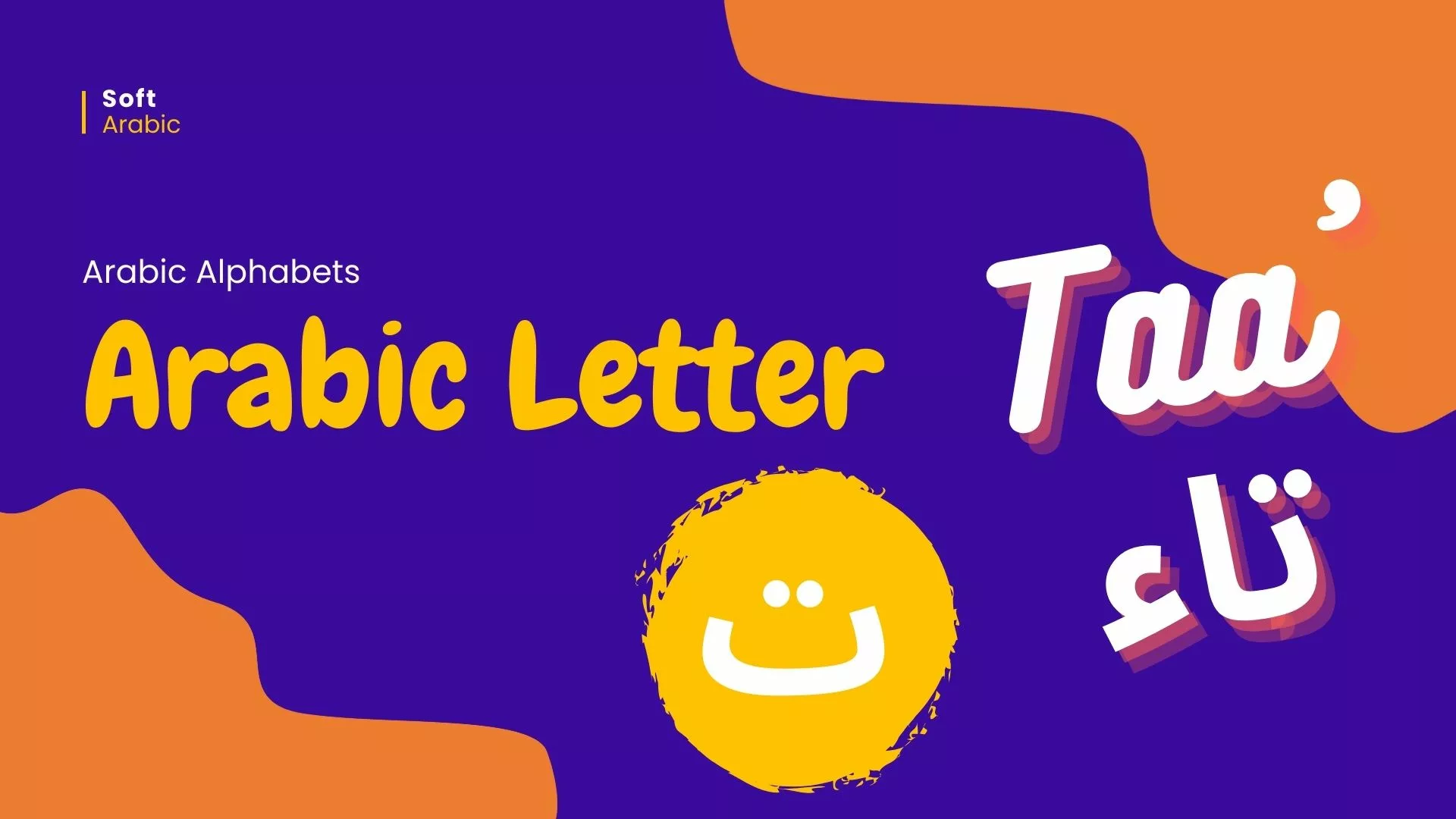Introduction
The Basics of Arabic Letter ‘ت’ (Taa)
Embark on a linguistic journey as we explore the third letter of the Arabic alphabet, ‘ت’ (Taa). As a consonant, ‘ت’ holds a significant place in shaping the phonetics of the Arabic language. Understanding the correct pronunciation of ‘ت’ is foundational for those venturing into the realm of Arabic, forming the building blocks for various words and expressions.
Table Of Contents
The different forms of the letter ‘ت’ (Taa)
Discover the versatility of ‘ت’ as it takes two different forms Flattened Ta’ [Ta’ Mabsuta (تاء مبسوطة)] and Tied Ta’ [“Ta’ Marbuta” (تاء مربوطة)] and based on each of these forms.
- Flattened Ta’: It appears in various positions within a word: initial, medial, final, or isolated.
- Tied Ta’: It is most frequently positioned at the end of feminine nouns to indicate the gender of the noun.
Contextualizing these forms enhances the ability to read and write Arabic scripts fluently.
| Contextual forms | Arabic Name | English Name | Translit. | Description | |||
|---|---|---|---|---|---|---|---|
| Isolated | End | Middle | Beginning | ||||
| ﺕ | ـت | ـتـ | تـ | تاء | tāʾ | t | – tāʾ is one of two “t” sounds, this one is almost like a little “t”. It is pronounced like the “t” in “ten”. – This form is called Ta’ mabsuta |
| ة | ـة | تاء | tāʾ | t | – This form is called Ta’ mabsuta | ||
🧡 Unlock the art and significance of each letter by visiting this enlightening link
The Letter ‘ت’ (Taa) with Diacritics (Short Vowels) Fathah, Dammah, Kasrah, and Sukūn
Dive into the world of diacritics, or “harakat,” and understand how Fathah, Dammah, Kasrah, and Sukūn shape the pronunciation of ‘ت’ in various linguistic contexts. These diacritics contribute to the nuanced articulation of the Arabic language, ensuring accurate communication.
| Short Vowel Sukūn | Short Vowel Kasrah | Short Vowel Dammah | Short Vowel Fathah |
|---|---|---|---|
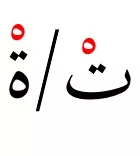 |  |  |  |
| قالتْ إن الخبر كان مفاجئًا | جمال الطبيعة لا ينتهي | أكلتُ الموز | .كتَبَ أحمد رسالة |
| Qalat in al-khabara kana mufaji’an. | Jamal at-tabi’a la yantahi. | Aklatu almoza. | Kataba Ahmed risalah. |
She said the news was surprising. | Nature’s beauty is endless. | I ate the banana | Ahmed wrote a letter. |
📚 Explore the enchanting way these vowels adorn each letter of the Arabic alphabet :
- Arabic Letters with Short Vowel Fathah
- Arabic Letters with Short Vowel Dammah
- Arabic Letters with Short Vowel Kasrah
The Letter ‘ت’ (Taa) with Diacritic (Short Vowel) Tanwīn
Explore the diacritic Tanwīn and its role in indicating short vowels. Positioned above the final consonant, Tanwīn guides the pronunciation of ‘ت,’ adding layers of complexity and richness to the language.
| Letter Taa with Tanwīn Kasrah | Letter Taa with Tanwīn Dammah | Letter Taa with Tanwīn Fathah |
|---|---|---|
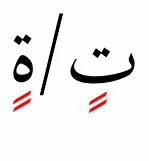 | 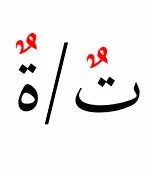 | 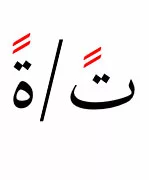 |
| ذهبنا في رحلةٍ إلى المنتزه | هذا بيتٌ جميل | ًأهداني زوجي وردة |
| Dhahabna fi rihlatin ila al-muntazah. | Hatha baytun jameelun. | Ahdaani zawji waradah. |
| We went on a trip to the park. | This is a beautiful house. | My husband gave me a rose. |
The Letter ‘ت’ (Taa) with Diacritic (Short Vowel) Shadda
Uncover the significance of Shadda, a diacritic denoting emphasis or consonant doubling, in the Arabic script. Shadda refines the articulation of ‘ت,’ contributing to the clarity and precision of spoken and written communication.
| Letter Taa with Shadda and Kasrah | Letter Taa with Shadda and Dammah | Letter Taa with Shadda and Fathah |
|---|---|---|
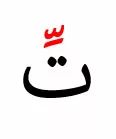 |  | 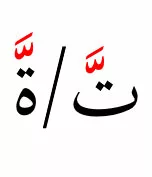 |
| يرتِّب الغرفة | التُّفاح وجبة خفيفة صحية | التَّربية تشكل قادة المستقبل |
| Yurattibu al-ghurfa | At-tuffah wajbat khafifah sahiyah | At-tarbiyah tashkul qada’ al-mustaqbal. |
| He arranges the room | Apples are a healthy snack. | Education shapes future leaders. |
The Letter ‘ت’ (Taa) with Diacritic (Short Vowel) Tanwīn with Shadda
Witness the intricate interplay between Tanwīn and Shadda as they combine to create a melodic and nuanced pronunciation of ‘ت.’ This diacritic duo adds depth to the phonetic expression of Arabic.
| Letter Taa with Tanwīn with Shadda and Kasrah | Letter Taa with Tanwīn with Shadda and Dammah | Letter Taa with Tanwīn with Shadda and Fathah |
|---|---|---|
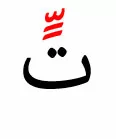 | 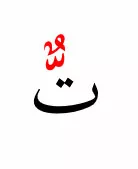 | 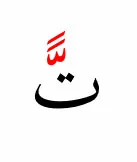 |
| هذا الأمر مٌتَعَتٍّ | سِتٌّ وسِتّون | يمنَعُ مَنْعاً باتّاً التدخين داخل الطائرة |
| Hatha al-amr muta’atin | Sittun wa sittun. | Yumnaa man’an battan at-tadkhin daakhil at-ta’ira. |
| This matter is very difficult | Sixty-six. | Smoking is strictly prohibited on board. |
The Letter ‘ت’ (Taa) with Long Vowels
Explore the rhythmic beauty infused by long vowels Alif (ا), Waw (و), and Yaa (ي) when combined with ‘ت.’ These long vowels bring grace, resonance, and elegance to the pronunciation, shaping the melodic quality of the language.
| Letter Taa with Long Vowel Yaa | Letter Taa with Long Vowel Wāw | Letter Taa with Long Vowel Alif |
|---|---|---|
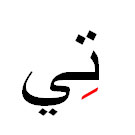 |  |  |
| العائلة هي حياتي | الحديقة بها أشجار تُوت | الكتَاب مفيد |
| Al-a’ila hiya hayati. | Al-hadiqah biha ashjar toot. | Al-kitab mufid. |
| Family is my life. | The garden has mulberry trees. | The book is informative |
You want to 🔍 Explore the fascinating world of all Arabic letters with long vowels!
The Melodic ‘ت’ Sound
Grasp the melodic blend of ‘ت,’ akin to ‘t’ as in “tan” and ‘th’ as in “thin.” The sound of ‘ت’ distinguishes between words, conveying specific meanings and adding a musical quality to the Arabic language.
| Contextual Form | Isolated | End | Middle | Beginning |
|---|---|---|---|---|
| Arabic | هِرَّة | بيت/مدرسة | كُتُبٌ | تُفَّاح |
| English Transliteration | hirratun | baytun/madrasatun | kotobun | toffahun |
| English Translation | cat(f) | house/school | books | apples |
| Image |  |  |  |  |
The Flattened Ta’ and Tied Ta’
The Arabic letter “ت” comes in two main forms: the “Ta’ Marbuta” (تاء مربوطة) and the “Ta’ Marbuta” (تاء مبسوطة). Let’s explore the characteristics and distinctions between these two forms.
1. Ta’ Mabsuta (تاء مبسوطة): Flattened Ta’
The Ta’ Mabsuta (also called open Ta’ – Ta’ maftuha) is the isolated form of the letter “ت” when it is not at the end of a word. Here are its distinctive features:
- Form: The Ta’ Mabsuta is written as a standalone letter (ت).
- Position: It is used when the letter occurs within a word, whether at the beginning, in the middle, or at the end.
- Pronunciation: It’s the Ta’ that is pronounced Ta’ consistently, whether in motion during speech or at a pause.
- Examples: In words like كتاب (kitāb) meaning “book” or تعليم (ta’leem) meaning “education,” the Ta’ Mabsuta is used in the middle of the word, not indicating femininity.
2. Ta’ Marbuta (تاء مربوطة): Tied Ta’
The Ta’ Marbuta is a unique letter in the Arabic script. It is typically found at the end of feminine nouns and carries a specific grammatical significance. Here are its key features:
- Form: The Ta’ Marbuta takes the shape of a circle with two dots on top ( ة / ـة ) and has an end and an isolated form as we have seen before.
- Position: only appears at the end of a word.
- Pronunciation: When in motion during speech (when it receives harakat: Fathah, Dammah, or kasrah), it is pronounced as a mobile “Ta’.” However, when at a static stop (the diacritic is sukun), it is pronounced as “Ha’.”
- Feminine Nouns: Ta’ Marbuta is commonly used in feminine nouns, indicating the gender of the noun. For example, كتابة (kitābah) means “writing,” where the Ta’ Marbuta denotes the feminine nature of the activity.
Stay tuned to discover more details on grammatical rules on when to use Flattened Ta’ and Tied Ta’ and all aspects of the letter Ta’ in a separate article.
Beyond the Basics: The Uses of ‘ت’
Unearth the diverse roles of ‘ت’ beyond its linguistic significance. From serving as a prefix in prepositions to becoming part of nouns, adjectives, and even numerals, ‘ت’ plays a multifaceted role in the Arabic language.
- Feminine Marker: “تاء التّأنيث” serves as a grammatical marker for feminine nouns. When added to the end of a masculine noun, it changes the gender to feminine.
- Example: Let’s take the word “student” in Arabic, which is “طالب” (Taaleb) in the masculine form. Adding “تاء التّأنيث” transforms it into the feminine form, making it “طالبة” (Taalibah), which means a female student.
- Taa as a pronoun : Al-Taa’ Dhamir Bariz (التاء ضمير بارز): This means that the letter “ت” (ta) in the verb is a pronoun, specifically indicating the first person singular (“I”).
- Example: “قرأتُ الكتاب” is the past tense of the verb “قرأ” (qara’a), which means “to read.” In this form, it is conjugated for the first person singular, indicating that the speaker (or the doer of the action) is the one who read. the connected pronoun “ت” (ta) is in the marked with “ضمة” (dammah), and it is in the place of the subject (fa’il), which is the speaker (“I”).
- Position in the Alphabet: Taa is the sixteenth letter in the Arabic Abjad system. It falls between the letters “Sheen” (ش) and “Thaa” (ث).
Conclusion: Embracing the Essence of ‘ت’
In conclusion, ‘ت’ transcends being a mere letter; it encapsulates the cultural richness, linguistic beauty, and artistic creativity of the Arabic language. Embrace the essence of ‘ت,’ where art, history, and language converge in a harmonious blend of expression.
Frequently Asked Questions
Q1: What is the Arabic letter ‘ت’ (Taa)?
A: The Arabic letter “ت” is the third letter of the alphabet, representing the sound “t” as in “tan” in English.
Q2: How do we pronounce the letter “ت” in Arabic?
A: The letter “ت” is pronounced as a voiceless dental stop, similar to the English sound “t” in words like “tan” or “table.”
Q3: What are some common words that start with the letter “ت”?
A: Common Arabic words include تَفَاحَةٌ (tafaahatun) meaning “apple,” تَكْتُبُ (taktubu) meaning “you write,” and تَلْمِيذٌ (talmeedhun) meaning “student.”
Q4: Can the letter “ت” be connected to other letters in Arabic writing?
A: Yes, the letter “ت” can seamlessly connect to other letters in Arabic script, allowing it to form words with fluidity.
Q5: Is the letter “ت” used in numbers in Arabic?
A: Yes, the Arabic letter “ت” represents the number 9 in Arabic numerals.
Q6: Are there different forms of the letter “ت” in Arabic?
A: Yes, like all Arabic letters, “ت” Taa has different forms: isolated, beginning, middle, and end forms, based on Its position within a word.
Q7: Can you provide examples of words where the letter “ت” appears in different positions?
A: Certainly! Examples include تَفَاحَةٌ (tafaahatun) in isolated form, تَكْتُبُ (taktubu) in beginning form, تَلْمِيذٌ (talmeedhun) in middle form, and زَهْرَةٌ (zahratun) in end form.
